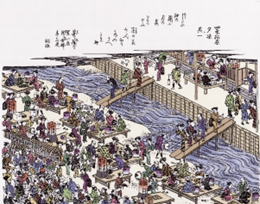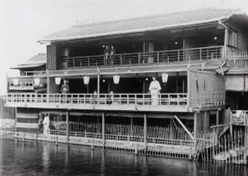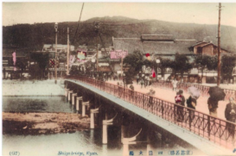Noryo-doko (Kamogawa evening coolness) 1
Yoshie Doi

Enjoying the cool evening breeze on the Kamogawa river in the Edo period |

Shijo Bridge in the Meiji period |
 |
 |
Sanjo Kawabata Minokichi Noryo-doko in the Taisho period
The Kamo River is now a place for citizens to relax, but for a long time it was a raging river. In the Jomon period, the river was about 700 meters wide from present-day Teramachi to Higashioji-dori, and it seems that it went south while changing its course. Both the water level and the width of the river are getting smaller now.

thin persimmons color
As Matsuo Basho wrote, “The river wind is wearing thin persimmons, it is evening. : wearing thin persimmons color Kimono,” and Yosa Buson wrote, “Susushisaya: Coolness, the river flows vertically through the capital.”
Kamogawa has long been a place to enjoy the cool evening breeze.
It is often referred to as “Kyoto of Sanshi Suimei”, but Sanshi Suimei was built in Sanbongi, Kamogawa, where Rai Sanyo moved six times in the nine years since he entered Kyoto in the late Edo period. It is a study and tea room called “Sanshi Suimei Dokoro”.
Originally, Sanshisuimei was a word that represented the time, but in Sanyo’s letter, he invited his friends to come to Sanshisuimei. It depends on the season, but it’s usually around 4:00 in the evening. The water surface is illuminated by the setting sun, and Higashiyama is dyed in pale purple. The Kamogawa River during this time is also attractive.
The custom of cooling off in the Kamogawa River during the hot summer seems to have existed since the Heian period, but it was Toyotomi Hideyoshi’s time that people started lining up a long stool as camp floor in the river to cool off in the evening. It is said that a wealthy merchant placed a long stool as a camp floor in the shallow waters of the Gojo River to entertain guests from afar during the hot summer of Kyoto.
Around the 2nd year of Kanbun (1662) in the early Edo period, Noryo Yuka was recorded as an annual event in Heiankyo. This started as an event related to the Gion-e (Gion Festival) as a large gathering of gods in the Shijo-gawara area, where children enjoy ‘river hunting’ in the daytime, and adults in the shallows in the evening. It put it down to cool off. The picture shows the lanterns lit up, and people holding uchiwa and folding fans to cool off. (Refer to “Miyako Rinsen Meishou Zue”)
Also, in the Edo period, Noryo Yuka was held in Tadasu no Mori. It was called Tadasu no Suzumi, and it seems that the floor was put out on the Mitarai River and it was crowded. (See illustration)
The evening coolness of Shijo Kawara is from June 7th to June 18th of the lunar calendar, the period before the Gion Festival (Sakimatsuri). The summer evening in Tadasu no Mori was held from June 19th to the last day of the year, along with the “Natsukoshi no Harae”.
During the Edo period, Shijo-gawara prospered as an entertainment district, but as a place for shows and theaters, mischievous people and Kabuki-mono strolled along the riverside, and Okuni Kabuki dances were performed at Shijo-gawara.
During the Meiji period, the noryo-yuka were installed for two months in July and August. It was put out to the south of Kuribashi (acorn bridge). Currently, from May 1st to September 30th, it is installed from Gojo to Nijo.
Due to the extension of the Keihan Electric Railway East Line in 1914, the bank on the left bank of the Kamo River disappeared, and due to flood control work, the river flowed faster and it was forbidden to place a floor on the river. The cooling floor on the right bank shifted to a stilt type.
In September 1934, the Muroto Typhoon headed north along the Yodo River and hit Kyoto directly. The repair work of the Kamo River at this time created the current Misogi River, and the Noryo-doko was built on top of it. In 1942, due to the self-restraint of business due to the Second World War, light blackouts, and the prohibition of entertainment, the Noryodoko was not performed at all around 1945 when the war ended. After the war, in 1950, several restaurant houses applied for the installation of floors. The Prefectural Department of Civil Engineering issued a notice “About the high floor of the Kamo River”, and the Kamogai Hoshokai was born at this time
Since 2008, based on the Kyoto Prefecture Kamogawa Ordinance, riverbeds have been regulated, and the riverbeds on the right bank of the Kamogawa River from Nijo Ohashi Bridge to Gojo Ohashi Bridge are examined with emphasis on the scenery such as the height, material, and color of the floor, and are related to landscape creation. They work with businesses and administration. In addition, the Kamogawa Noryo-doko examination criteria guidelines were established.
The end of document
